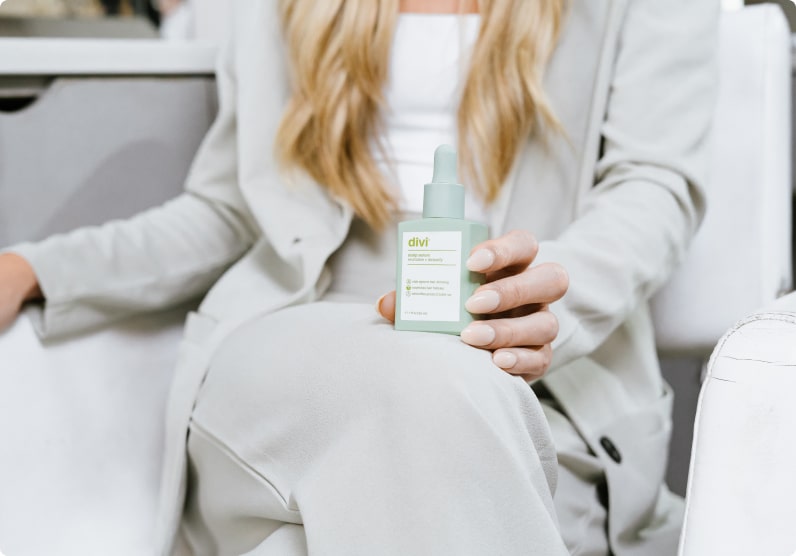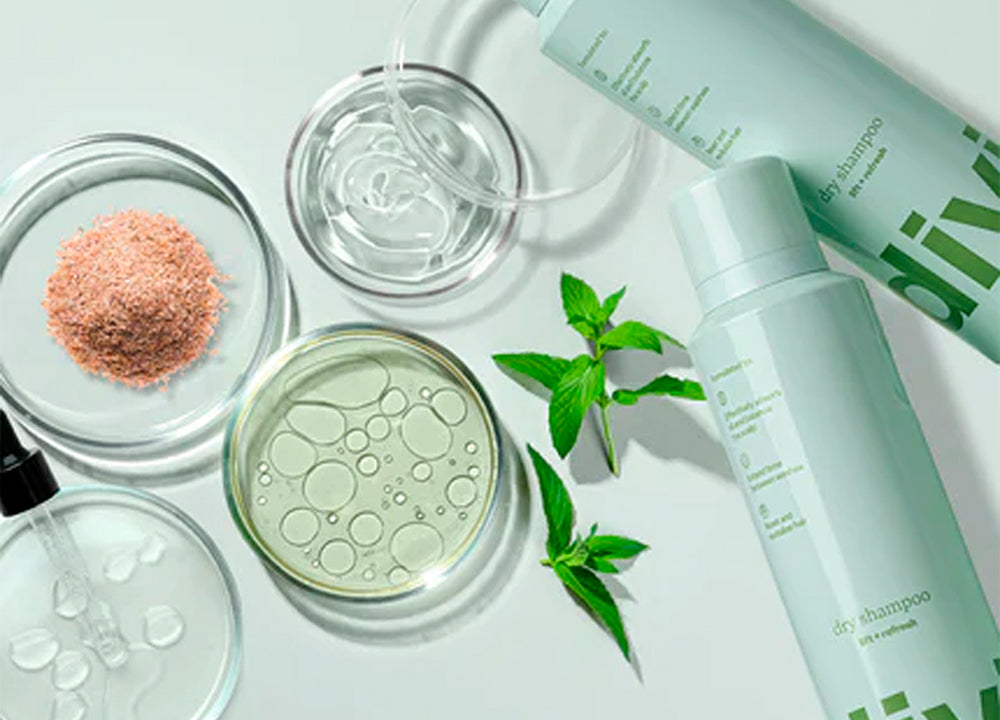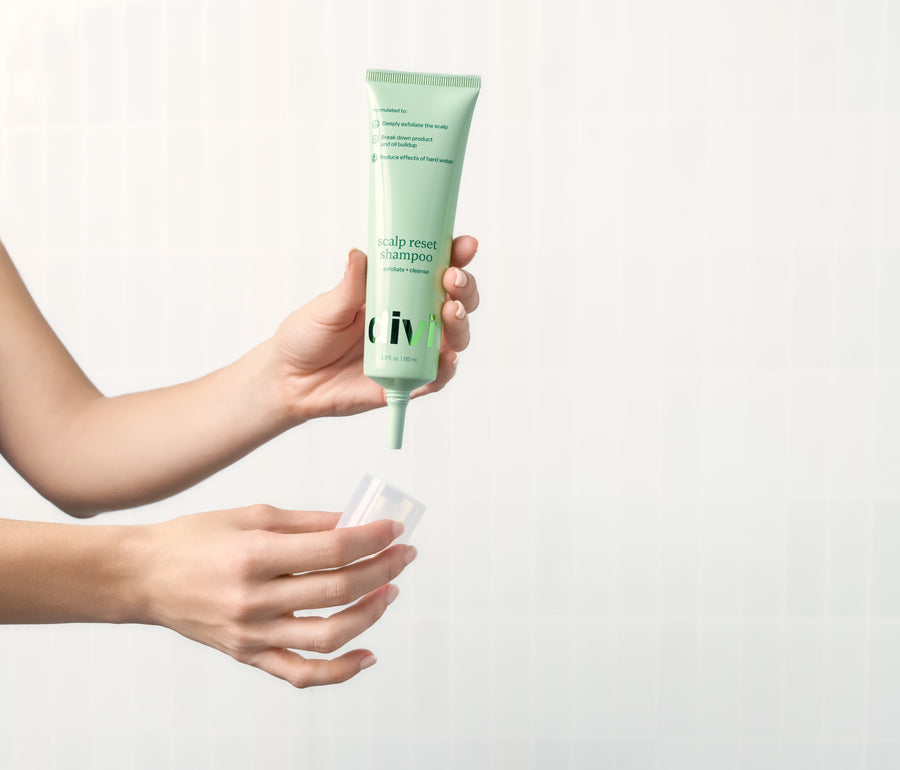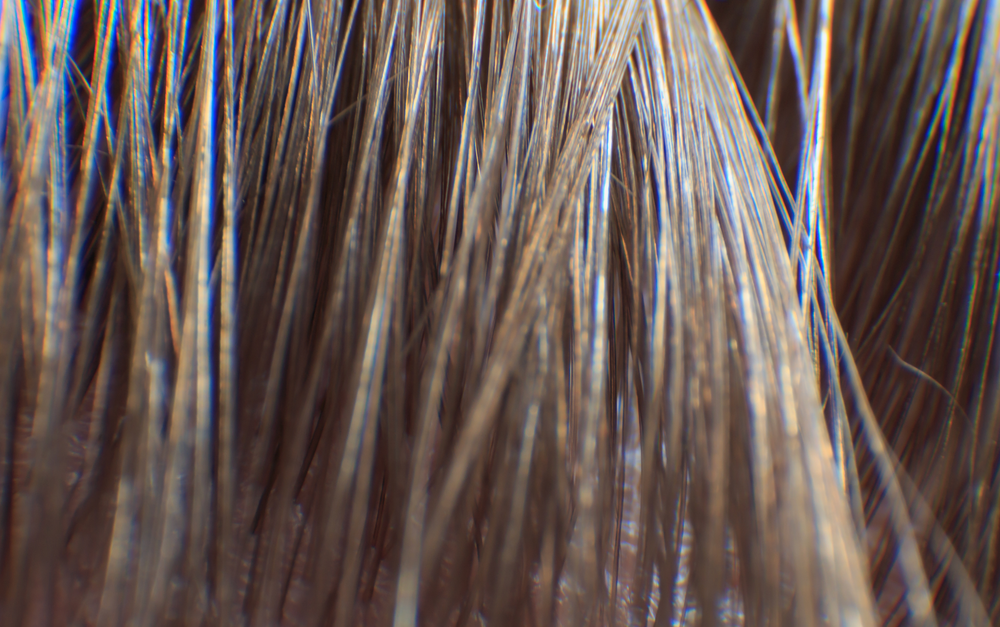Folliculitis is a common, generally benign, skin condition, often caused by inflamed hair follicles. It can occur anywhere on the skin or scalp and resemble an itchy and uncomfortable pimple.
There are different types of folliculitis, each based on the cause, infectious organism, and its effect on the skin. Folliculitis may result from bacterial infection, blockage, irritation, skin diseases, and fungal or viral infections.

Folliculitis can result from everyday activities, such as improper or frequent shaving, excessive sweating from working outside or exercising, tight clothes and poor hygiene.
Divi offers scalp care products such as our Shampoo, Conditioner, and Scalp Serum to help with folliculitis by hydrating the skin, boosting collagen production, ridding the scalp of fungus and bacteria, and reducing inflammation.
Before discussing the specific benefits of Divi’s lineup, let’s explain what folliculitis is and how it can be treated.
What are the Types of Folliculitis?
There are two main types of folliculitis: superficial folliculitis and deep folliculitis. Superficial folliculitis is characterized by partial damage to the hair follicle, while deep folliculitis is when the entire hair follicle is damaged.
These are some non-bacterial forms of folliculitis.
Razor Bumps (Pseudofolliculitis Barbae)
This type of folliculitis is caused by ingrown hairs linked to shaving or bikini waxing, not infected hair follicles. The rash appears like "razor bumps," dark keloids, or bumps on the face or neck after shaving or in the groin area after waxing.
Phrynoderma
Phrynoderma is a form of follicular hyperkeratosis associated with nutritional deficiency, including vitamin A or vitamin C deficiencies. Patches initially arise on the back of the elbows and the front of the knees and can spread to the upper forearms and thighs.
Actinic Folliculitis
Actinic folliculitis is a rare pustular dermatosis occurring in some people after intense sun exposure. This typically appears within 24 hours after sun exposure and usually resolves within 7-10 days, but it can take up to three weeks. This condition can be minimized or prevented by using sunscreen before and during sun exposure.
Gram-Negative Folliculitis
This type of folliculitis develops in people receiving long-term antibiotic therapy for acne. It causes pus-filled bumps around the nose and mouth.
Sycosis Barbae
Sycosis Barbae is a form of chronic folliculitis in the beard area of the face in men and some women. The entire hair follicle is often infected, causing large red bumps to appear, primarily on the upper lip. The skin is painful and crusty when shaving, with itching and burning sensation.
Eosinophilic Pustular Folliculitis
Eosinophilic folliculitis typically affects babies or people with a condition affecting their immune system. It mainly affects people with HIV/AIDS. It causes intensely itchy, pus-filled pimples and bumps that form near the hair follicles on the face and upper body.
How Common is Folliculitis?
Folliculitis is a widespread skin condition many people experience, which can occur in infants, children, men and women.
Certain types of folliculitis are more likely to occur in certain groups of people. For example, pseudofolliculitis barbae is a type of folliculitis caused by ingrown hairs linked to shaving. This condition is most common in men who frequently shave their face.
Folliculitis can appear anywhere you have hair, as this condition occurs when the hair follicles are blocked or infected.
What are the Symptoms of Folliculitis?
Symptoms of folliculitis will vary based on the exact type of folliculitis and its severity. In most cases, the main symptoms of folliculitis are:
- Groups of small red bumps like pimples around hair follicles, some with white heads
- Pus-filled blisters that break open, ooze, and crust over
- Itchy or burning skin
- Uncomfortable, painful or tender skin
- An inflamed bump or larger areas of red, swollen skin
Does Folliculitis Cause Hair Loss?
Folliculitis decalvans is a rare condition that causes chronic hair follicle and scalp inflammation. This condition can cause permanent hair loss with scarring (cicatricial alopecia) in both men and women.
The cause of folliculitis decalvans is unknown, but experts suspect a staphylococcus infection (staph infection) may be to blame. Folliculitis decalvans usually affects only the scalp, causing circular-shaped bald spots. In rare cases, hair loss does not occur in other areas but can also affect the armpits, face, legs, arms and genitals.
Some people may have no noticeable symptoms until experiencing hair loss, while others may have an itchy scalp that feels like dandruff.
Factors Increasing the Risk of Getting Folliculitis
Anyone can develop folliculitis, but common risk factors that increase your chances of getting this condition include:
- Regularly wearing tight clothing that traps sweat and heat and rubs against your skin
- Touching, rubbing, or scratching skin frequently
- Damage to the hair follicles caused by shaving, waxing, certain hairstyles (like wigs and tractions) or tight clothing
- Sitting in a hot tub or public pool that's not well cleaned or maintained
- If you have been using oral antibiotics for an extended time, including long-term antibiotic therapy for acne, corticosteroid creams, prednisone and certain chemotherapy drugs
- Having an illness that affects your immune system, like diabetes, leukemia or HIV/AIDS
- Excessive sweat or having dermatitis
The Difference Between Fungal and Bacterial Folliculitis
The main difference between bacterial and fungal folliculitis is its cause. Bacterial folliculitis is when bacterial infections, such as Staphylococcus aureus and Pseudomonas aeruginosa, enter one or more hair follicles. In contrast, fungal folliculitis is when fungal infections, such as Trichophyton rubrum and Malassezia globosa, enter one or more hair follicles.
Bacterial folliculitis is the most common type and is characterized by itchy, white, pus-filled bumps. Hot tub folliculitis (pseudomonas folliculitis) is a common type of folliculitis that you can get from a dirty swimming pool or hot tub. This causes what is known as ”hot tub rash.”
Pityrosporum folliculitis, also known as Malassezia folliculitis, is a common fungal folliculitis that occurs due to a yeast infection. Malassezia is a family of yeast usually found in the skin, and sometimes it can get into the hair follicles, causing red, itchy, pus-filled pimples. It usually appears on the upper body, mainly on the back and chest, but can also occur on the face, neck, shoulders and arms. This type of folliculitis is aggravated by sweat.
Can You Prevent Folliculitis?
Folliculitis infections usually involve yeast and bacteria entering your hair follicles. By changing some parts of your regular self-care routine, you can limit the infectious material in your hair follicles and your chances of developing folliculitis.
Here are a few steps you can take:
- Wash your skin regularly — Use warm water, a gentle cleanser and a clean towel each time.
- Use Divi products – Divi's lineup of scalp care products has been scientifically formulated to help combat folliculitis symptoms. Divi's Scalp Serum is specially formulated to help treat fungal infections and irritated skin symptoms.
- Do laundry regularly – Use hot, soapy water to wash clothes, uniforms, towels and washcloths.
- Avoid shaving, if possible – Letting your hair grow can help, but if you can't avoid shaving, use a clean blade each time and shave in the direction of hair growth.
- Avoid friction or pressure on the skin – Avoid wearing tight clothes, hats or helmets, or any clothing item that may trap heat or rub against your skin.
- Limit greasy or oily skin products – These can cause blockages and trap bacteria in the hair follicles.
- Use clean hot tubs and heated pools – Pools and hot tubs can cause what is known as hot tub rash, so shower with soap and wash your swimsuit after swimming.
How is Folliculitis Diagnosed?
To diagnose folliculitis, your doctor or healthcare provider will examine your skin and ask about your family history. They may ask questions such as:
- How long have you had the bumps on your skin?
- What other symptoms do you have?
- Do you have a history of folliculitis in your family?
To identify the cause of your type of folliculitis, doctors may take a sample of one of the bumps or a skin swab for testing.
Common Complications of Folliculitis
Although folliculitis is not life-threatening, some complications are possible, including:
- Recurrent or spreading follicle infections
- Permanent hair loss from follicle damage
- Scarring or patches of skin that are darker (hyperpigmentation) or lighter (hypopigmentation)
- Cellulitis, which is infection of the skin
- Furunculosis, which boils under the skin
How is Folliculitis Treated?
Folliculitis is usually mild and goes away without treatment, while in some cases, more aggressive treatment may be necessary.
Treatment options for folliculitis depend on the type and severity of the condition. Always consult your healthcare provider on treatment options, as they'll know exactly what you need. You should meet with a dermatologist (skin doctor) before beginning any over-the-counter medication.
If you have mild folliculitis, you can sometimes treat it at home. There are several ways you can care for your irritated skin.
A Skin and Hair Care Routine
Science-backed skin and hair care products, like Divi's Scalp Serum, will help prevent infections and inflammation from occurring due to harsh toxic chemicals that may trigger folliculitis.
Medication
Various types of medicine are available for folliculitis, including topical and oral antibiotics, antifungal creams and shampoos, steroid creams, and medication for fungal or bacterial infections.
If your folliculitis is returning not improving, or severe, speak with your healthcare provider. They may prescribe oral antibiotics or a strong steroid cream to help.
Light-Based Therapy
In severe cases, your doctor may recommend light-based therapy to treat folliculitis. This type of treatment can help improve symptoms of deep folliculitis.
Laser Hair Removal
Your doctor may suggest laser hair removal to help reduce folliculitis caused by frequent shaving, such as pseudofolliculitis barbae. This treatment destroys the hair follicles, preventing bacteria, fungi or viruses from infecting them.
Multiple treatments are usually required to see results.
When Should You See a Doctor About Folliculitis?
Folliculitis can typically resolve on its own. However, if symptoms do not clear up independently after a few days or worsen, it is best to contact a medical professional.
Contact your doctor if:
- The bumps are bothersome or painful
- They are not improving or continue to appear
- There is a large, painful, red area of skin that feels hard or has a lot of drainage
Folliculitis and Divi
Divi's Scalp Serum, Shampoo, and Conditioner contain scientifically proven ingredients to assist with folliculitis symptoms on your scalp. Some of these ingredients linked to helping with folliculitis are:
- Glycerin – Glycerin can effectively hydrate the skin, which can help when the skin becomes itchy or dry due to folliculitis.
- Tea tree oil – Tea tree oil has antifungal properties that can fight any infection that may arise.
- Green tea extract – The antimicrobial and antifungal properties of green tea extract help to get rid of spores and bacteria that can cause infection.
- Rosemary leaf extract – Rosemary leaf extract has antifungal properties.
- Eucalyptus oil – Eucalyptus oil is antimicrobial and helps fight inflammation.
- Copper Tripeptide-1 – This antioxidant doesn’t irritate the scalp and helps to ensure healthy immune system functioning of the scalp.
- Menthol – The soothing properties of menthol can help curb the urge to scratch if hair follicles become infected.
Important Facts About Folliculitis
Here are some more facts about folliculitis:
- Most types of folliculitis improve in 7-10 days. When the rash is gone, dark marks may be left behind, but they are not scars and will go away with time.
- Folliculitis is not an autoimmune disease. It is typically an infection caused by bacteria, shaving, skin injury, tight clothing, heat or exposure to hot water. Folliculitis is curable and usually heals within a few days.
- Folliculitis is generally caused by body or facial bacterial infections from poor hygiene practices and self-care habits.
- Folliculitis shares a similar clinical manifestation as skin conditions like acne vulgaris, psoriasis, eczema or dermatitis. It can be hard to distinguish between them and lead to a misdiagnosis.
- Divi's Scalp Serum can help treat the symptoms associated with folliculitis on the scalp, providing much-needed relief.











































 Scalp Serum
Scalp Serum
 Scalp Reset Shampoo
Scalp Reset Shampoo
 Dry Shampoo
Dry Shampoo
 Best Sellers Bundle
Best Sellers Bundle
 Weekly Reset Duo
Weekly Reset Duo
 Root Touch Up
Root Touch Up
 Strand Plumping Styling Cream
Strand Plumping Styling Cream
 Root Reset Duo
Root Reset Duo
 3-in-1 Leave-In Conditioner
3-in-1 Leave-In Conditioner
 Air Dry Cream
Air Dry Cream
 Wash Day Essentials
Wash Day Essentials
 Frizz-Fighting Trio
Frizz-Fighting Trio
 Home & Away Dry Shampoo Bundle
Home & Away Dry Shampoo Bundle
 Volumizing Shampoo & Conditioner
Volumizing Shampoo & Conditioner
 Jumbo Volumizing Shampoo & Conditioner
Jumbo Volumizing Shampoo & Conditioner
 Volumizing Starter Bundle
Volumizing Starter Bundle
 Major Volume Bundle
Major Volume Bundle
 Volume Rescue Trio
Volume Rescue Trio
 Hydrating Shampoo & Conditioner
Hydrating Shampoo & Conditioner
 Whipped Repair Treatment Mask
Whipped Repair Treatment Mask
 Hydrating Starter Bundle
Hydrating Starter Bundle
 Hydration Heroes
Hydration Heroes
 Travel-Sized Volume Duo
Travel-Sized Volume Duo
 Travel-Sized Hydrating Duo
Travel-Sized Hydrating Duo
 Divi's Discovery Set
Divi's Discovery Set
